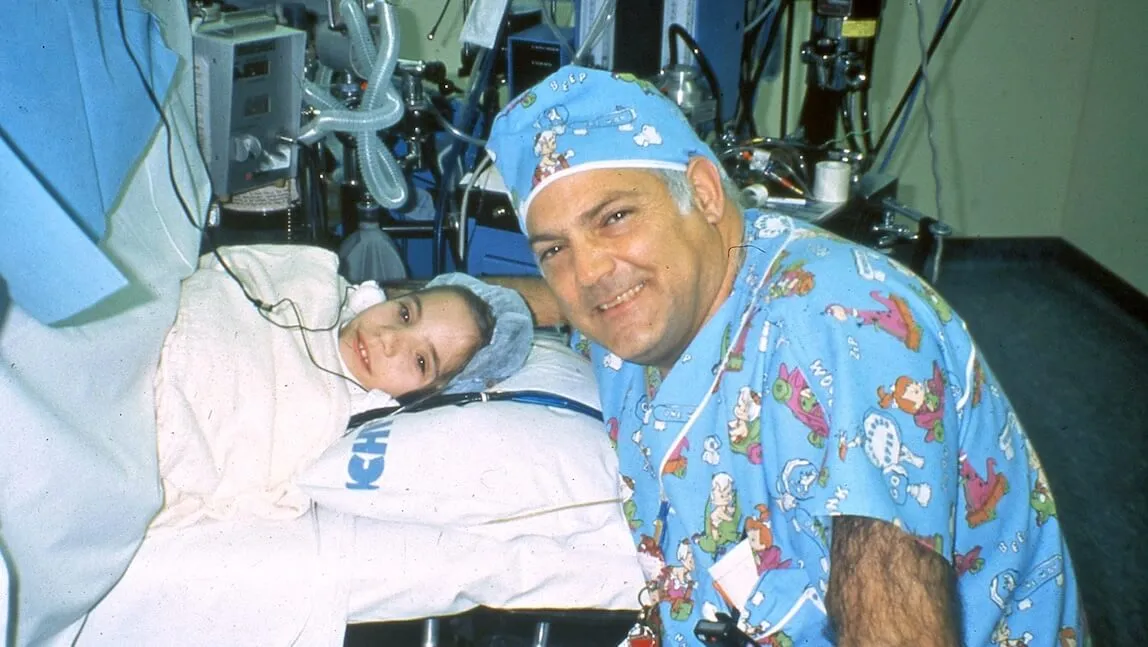There was never much doubt that Chris Abajian ’65, M.D.’69 would be a pediatric anesthesiologist. He was born in July 1943 at Atlanta’s Crawford Long Hospital, an institution named after one of the discoverers of surgical anesthesia. And he was the eldest son of “Big John” Abajian, the legendary founder of UVM’s Division (now Department) of Anesthesiology. But most important, Chris’ endearing personality overflowed with a playful kindness that children love, an essential attribute for a pediatric caregiver. “I never wanted to grow up,” he once said. “I’m still just a kid at heart.”
In late June, UVM and the Larner College of Medicine at UVM lost one of the most innovative and interesting alumni in their long history with the passing of Chris. He studied computer science as a UVM undergraduate in the early 1960s, then enrolled at the UVM College of Medicine, excelling at clinical training his last two years. After an anesthesiology residency at Royal Hammersmith Hospital in London and a pediatric anesthesiology fellowship at Toronto’s Hospital for Sick Children, he joined the UVM Division of Anesthesiology in 1974, just as his father was easing toward retirement. “Big John” had always been a proponent of regional anesthesia techniques as a safer alternative to general anesthesia and he passed this philosophy on to his son, who quickly made it his own. Thus, it was only natural that in late 1977, when asked to anesthetize an ill premature infant with a large inguinal hernia, Chris searched for an alternative to general anesthesia, the standard of care for neonatal surgery at the time. A quick literature search turned up an English report of spinal anesthesia in children under a year of age published in 1909. So, encouraged by UVM surgeon Paul Mellish and aided by NICU nurse Rose Anderson, Chris administered the first infant spinal anesthetic in modern history. “The spinal worked, and it was beautiful,” he recalled years later. “I just stood there and looked at the baby, and he was happy as can be, and we fixed the hernia. I was in awe really, especially when I thought of all the dangers that I’d avoided.”
More such spinals followed, and in 1984 Chris published his experience with 81 infant spinals – 36 in “high risk” infants, with 100 percent success – in the journal Anesthesia
and Analgesia. Not all anesthesiologists were receptive to the rediscovered technique at first, but it was gradually accepted by the worldwide anesthesia community. Forty
years later, infant spinal anesthesia is an essential part of the pediatric anesthesiology armamentarium and is considered one of the greatest advances in neonatal surgical care of the last half century. UVM continues to be a world leader in the technique, with its infant spinal database – now called the Vermont Infant Spinal Registry – containing detailed information on over 2,000 cases.
Throughout his career, Chris strove to make anesthesia a less frightening experience for his patients and their families. In the late 1980s, he began experimenting with surgical scrubs made of fabric with colorful patterns like teddy bears or balloons, all sewn by his wife, Margaret. They were a huge success and spawned the creation of a company, Huggable Scrubs, that produced a full line of surgical attire made of material featuring licensed cartoon characters. The idea was widely imitated and themed scrubs are now commonplace around the world. Several years later, Chris began to encourage parents to accompany their children to the operating room for anesthesia induction, relieving another source of anxiety. “Parental presence” is now the standard of care at children’s hospitals worldwide. In the 1990s, Chris became an accomplished amateur magician, using magic to earn the trust of his patients and distract them from the frightening task ahead. Some of his tricks were quite advanced, but the Fun Magic Coloring Book was a staple, so simple to perform that even anesthesia providers less gifted than Chris could do it. The “Magic Man,” as he came to be known, enjoyed the performances as much as his patients did.
For his numerous contributions to the specialty of pediatric anesthesiology, in 2013 Chris was named the recipient of the prestigious Robert M. Smith Award by the American Academy of Pediatrics, and in 2019 UVM’s Department of Anesthesiology established the Chris Abajian, M.D. and Margaret Abajian Green and Gold Professorship in Pediatric Anesthesia, its first such professorship, to honor Chris and Margaret for their years of service.
Always modest, Chris often used to say, “You know, I’ve been lucky. Better lucky than good.” And in Armenian, the word commonly used for goodbye, hajoghutyun, literally translates to “successfulness” or “good luck,” highlighting the culture’s emphasis on positivity even in tragic circumstances. Goodbye and continued good luck, old friend.
(Joseph M.Kreutz, M.D., is an Associated Professor Emeritus of Anesthesiology at the UVM Larner College of Medicine)
